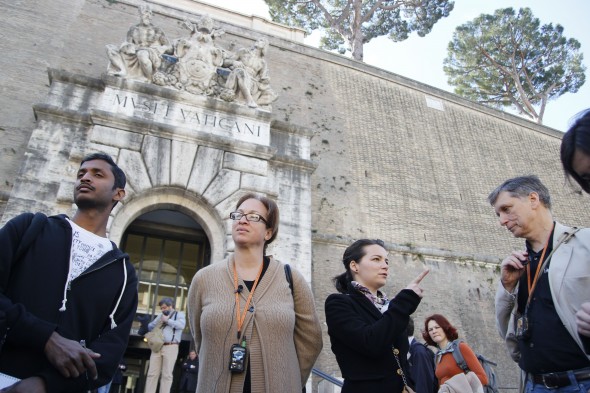By Ines Novacic

Michelangelo himself was inspired by The Belvedere Torso at the Vatican Museum. | Photo by Ines Novacic.
In each of our hotel rooms, a religious-themed painting hangs on the wall. Not quite as Catholic of a reminder as a crucifix, but enough to impress upon us where we are, and in which religious culture.
In Rome, Catholicism really is “culture”, not just the official religion.
During our trip to the Methodist Church on the first day of our trip, the Rev. Kenneth Howcroft — remarked that “when religion becomes culture, culture becomes religion.” I struggled to dissect the meaning behind this, because it seemed a somewhat muddled way to state the obvious without shedding light on much else. But I thought about it and Italian sociologist Roberto Cipriani’s idea of “diffused religion” came to mind. Cipriani argued more than 20 years ago that the secularization of religious practices did not signal the end of religion, but that moving religious rites from the Church to the home, office and other non-sacred spaces demonstrated the saturation of religion in Italian culture.
Throughout the next two days of our trip, I couldn’t help but notice that the art we encountered validated this theory – that religion informs culture to the point of subsuming it – perhaps more than anything else.
I’m not going to try pin down the meaning of “art,” but most will agree that it’s a key cultural product. Art objectifies cultural “signs” a la Clifford Geertz. The subject matter of art stems from the artist’s inner experience, and the signs that exist in the world the artist inhabits.
Religious art is abundant in places like Rome because religion is sprinkled atop the web of Italian culture – from education to politics and health to social convention. Artists internalize and respond to this; and patronage is available to showcase these artists, whether a hotel that commissions third-rate religious portraits—mostly of the Virgin Mary and baby Jesus — or a Pope that commissions awe-inspiring art like the Sistine Chapel ceiling.
We had the pleasure of seeing several works by Michelangelo on our visit to the Vatican Museum earlier today. As our tour guide extraordinaire, the art historian Dr. Elizabeth Lev, pointed out – the birth of the modern museum occurred within Vatican walls, namely the circular pantheon-like chamber, with about a dozen statues of pagan gods. It flourished, grew and now attracts more than five million visitors every year, because very wealthy and influential figures like Pope Julius II funded it and ensured that emphasis on religious work endured.

Dr. Lev stands with the Religio team in the courtyard of the Vatican Museum. | Photo by Ines Novacic.
Something like the Sistine Chapel ceiling could never have depicted anything non-religious, specifically non-Catholic, because religion is culture in Rome – for secular art, patrons would be scarce, an audience scarcer and the art itself perhaps not as impressive, since the artist cannot help but have something to express about the impression religion has made on his personal experiences.
“It’s incredible,” was the consensus among our class, about the “Pietà” in St. Peter’s Basilica. “Amazing,” the usual reaction to works like da Vinci’s “Adoration of the Magi.” They really do take your breath away. But if we pause to think why, and whose breath is most compromised, it’s those who know about the story behind the painting, who understand the beauty behind the inexplicably delicate grip that Michelangelo’s Mary has on Jesus’s marble flesh.
We are most affected by the art whose subject matter we are most in awe of. Religious art is by far the most impressive in Rome, because religion is impressed so completely on the lives of the people in this city.